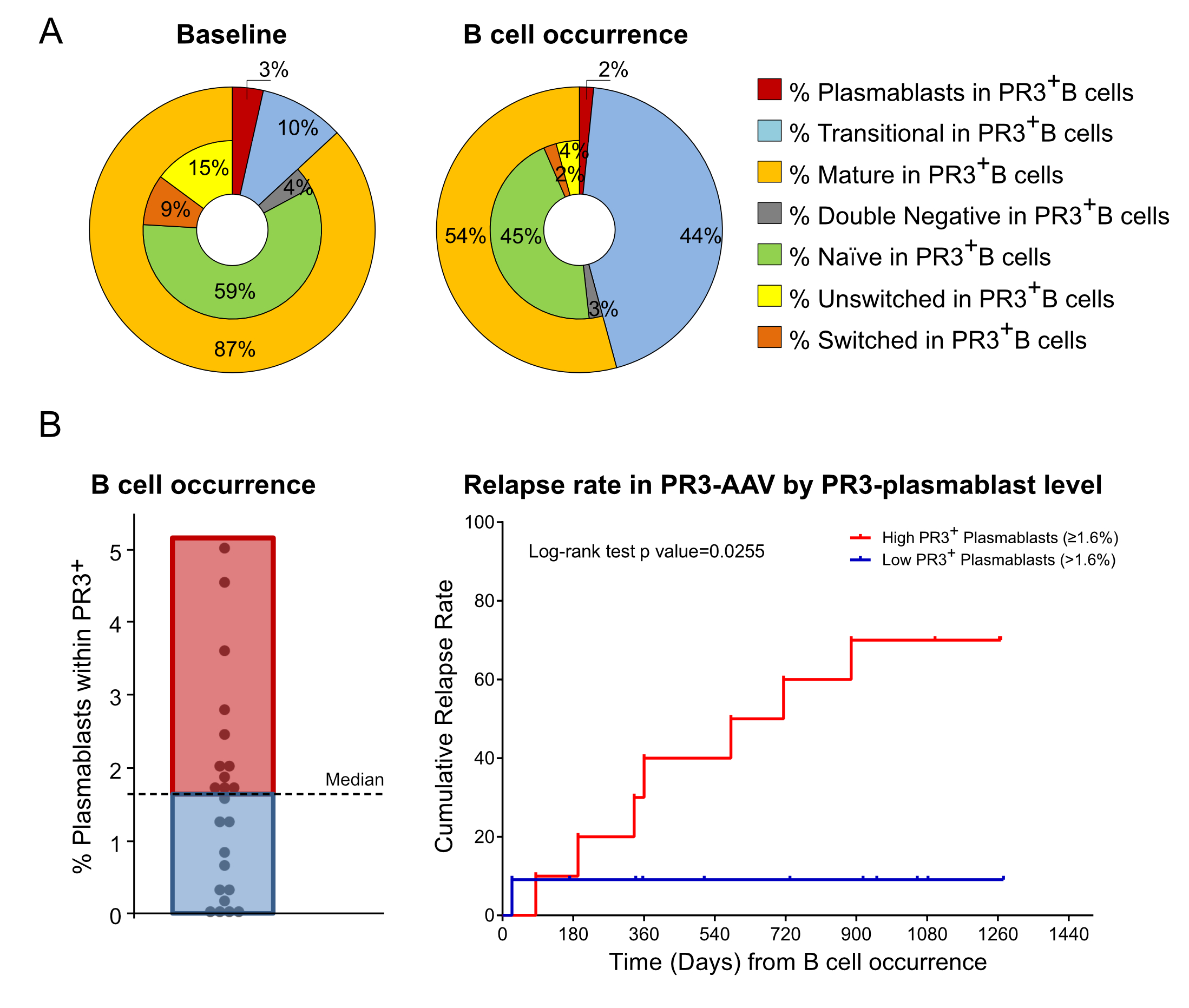Session Information
Session Type: Poster Session C
Session Time: 9:00AM-11:00AM
Background/Purpose: In ANCA-associated vasculitis (AAV) B cells play a central pathogenic role and are instrumental for the production of ANCA, which are thought to mediate disease activity by triggering the activation and degranulation of neutrophils.
We hypothesized that changes in the circulating proteinase 3 (PR3) reactive B cell (PR3+ B cell) pool at the time of B cell recurrence after treatment with rituximab (RTX) and/or during the subsequent follow-up mirror disease course and relapses of PR3-AAV.
Methods: We performed sequential flow-cytometry on 148 samples of peripheral blood mononuclear cells (PBMC) from 23 well-characterized participants in the Rituximab for ANCA-Associated Vasculitis (RAVE) trial, treated with RTX for induction of remission and during long-term follow-up off therapy. Clinical data and outcomes were correlated with numbers of B cells and PR3+ B cells; survival analyses and case-time-control analysis were performed by conditional logistic regression.
Results: Ten (43%) patients relapsed during the follow-up, 8 (35%) with severe disease. At baseline, clinical features, PR3-ANCA levels, PR3+ B cells, and PR3+ B cell subsets were similar between patients who relapsed (relapsers) and who did not relapse during the observation period (non-relapsers). All patients were studied for ≥18 months (observation period of the trial), for a mean of 44 months (25-75%IQR 31-54), without significant difference between relapsers and non-relapsers (p=0.98).
Two patients repopulated their B cells at 6 months; one relapsed and one did not during the follow-up. Total B cell counts and frequency were lower at B cell recurrence compared to baseline (p< 0.01). In contrast, the frequency of PR3+ B cells was higher at B cell recurrence (p< 0.01), and pairwise comparisons showed that both B cell and PR3+ B cell frequencies of transitional and naïve B cells were higher, while mature, unswitched and switched memory B cells were lower at the time of B cell recurrence compared to baseline (p< 0.001 in all comparisons) (Figure 1A).
At B cell recurrence, B cell subpopulations did not differ between relapsers and non-relapsers, while plasmablasts within the PR3+ B cell pool were higher in relapsers, and associated with a shorter time to relapse (Figure 1B). Increased numbers of PR3+ plasmablasts were more likely to be found in patients that relapsed in the following 12 months (p< 0.05), and this increase was 50% more likely to occur in relapsers when compared to non-relapsers.
Conclusion: Our findings describe the restructuring of B cell and PR3+ B cell compartments after B cell depletion with rituximab in PR3-AAV, and contribute to clarifying how early changes within the PR3+ B cell pool associate with the future outcome of the patients with PR3-AAV. Our results highlight the importance of the expansion of peripheral blood PR3+ B cells, which are linked to subsequent relapses. These findings contribute to a better understanding of the mechanisms governing the reconstitution of antigen-specific B cells after treatment with RTX in AAV.
 Figure 1. PR3+ B cells at baseline and B cell recurrence (A) and plasmablasts among the PR3+ B cell pool at B cell recurrence (B) among subjects with ANCA-associated vasculitis treated with rituximab.
Figure 1. PR3+ B cells at baseline and B cell recurrence (A) and plasmablasts among the PR3+ B cell pool at B cell recurrence (B) among subjects with ANCA-associated vasculitis treated with rituximab.
To cite this abstract in AMA style:
Berti A, Hillion S, Casal Moura M, Hummel A, Carmona E, Peikert T, Langford C, Merkel P, Monach P, Seo P, Spiera R, St Clair E, Fervenza F, Harris K, Stone J, Pers J, Specks U, Cornec D. Proteinase 3-Reactive B Cell Pool Restructuring After Rituximab and Risk of Relapse in Severe PR3-ANCA-Associated Vasculitis [abstract]. Arthritis Rheumatol. 2020; 72 (suppl 10). https://acrabstracts.org/abstract/proteinase-3-reactive-b-cell-pool-restructuring-after-rituximab-and-risk-of-relapse-in-severe-pr3-anca-associated-vasculitis/. Accessed .« Back to ACR Convergence 2020
ACR Meeting Abstracts - https://acrabstracts.org/abstract/proteinase-3-reactive-b-cell-pool-restructuring-after-rituximab-and-risk-of-relapse-in-severe-pr3-anca-associated-vasculitis/
